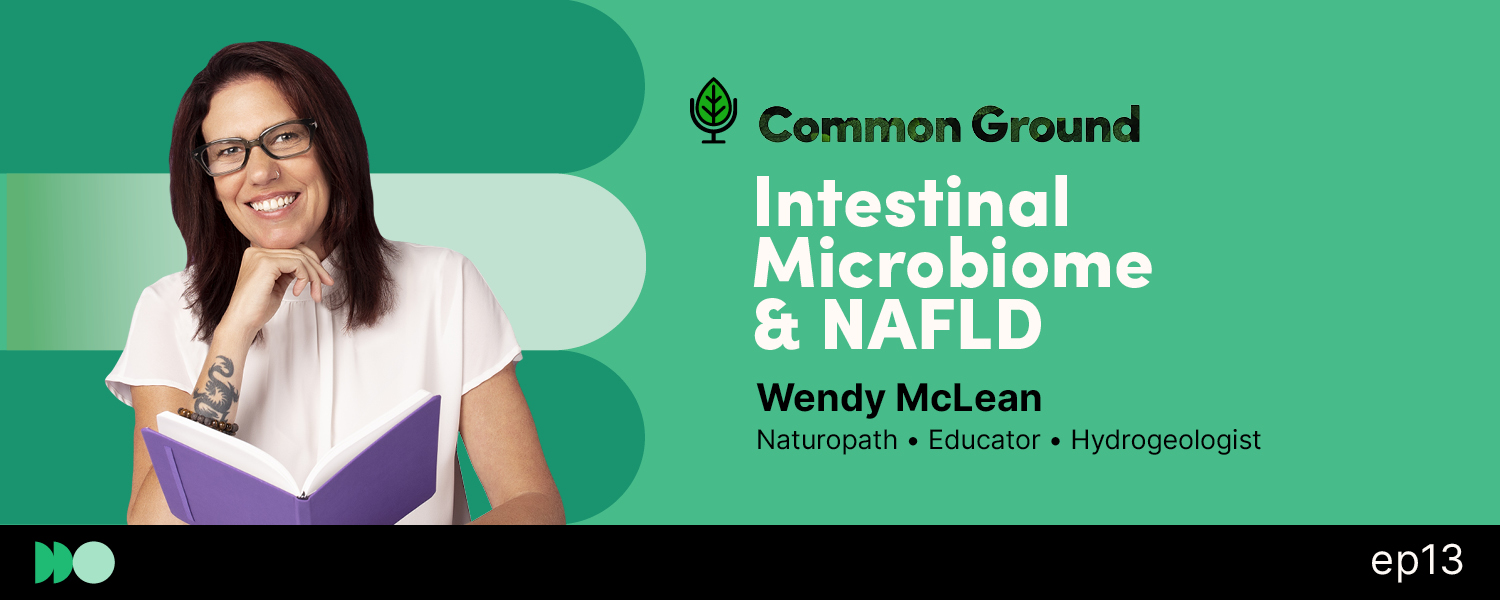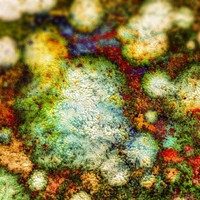
Listen on Amazon music | Apple Podcasts | Google Podcast | Spotify
Transcript
Welcome to Common Ground, a podcast series discussing new research and interesting projects in the field of complementary medicine. Hello, my name is Wendy McLean educator at vital.ly.
vital.ly is a digital platform, a professional health resource, and a distribution service all in one.
Firstly, I'd like to begin by acknowledging the Gadigal people of the Eora nation as the traditional custodians on the land, on which we gather here. I would also like to pay my respects to their elders both past and present.
Today on Common Ground I am looking at the role of the gut microbiome in the development of the most common liver disease, non-alcoholic fatty liver disease, or NAFLD. The pathogenesis of NAFLD is complex and not fully understood. However, it is now known that dysregulation of gut microbiota and their metabolites play a key role in its development. Therefore restoring the gut microbiota through diet and nutritional interventions, such as pre and probiotics can be of therapeutic benefit against this chronic disease.
Non-alcoholic fatty liver disease is the most common chronic liver disease, both in Australia and worldwide. Due to its steadily increasing prevalence and increasingly young age at diagnosis, it represents a growing challenge in terms of both prevention and treatment. NAFLD is estimated to be present in 25 to 45% of the general population and in as many as 15% of children and adolescents.
NAFLD represents a spectrum of liver disease severity beginning with the accumulation of fat in the liver termed steatosis. Almost a quarter of individuals with steatosis will develop liver inflammation and progress to a more severe form called non-alcoholic steatohepatitis or NASH. However, unlike simple steatosis NASH is not reversible and can eventually progress into fibrosis, cirrhosis, or even hepatocellular carcinoma.
NAFLD is closely associated with many features of metabolic syndrome, including obesity, insulin resistance, hyperlipidemia, and hypertension, and it increases the risk of cardiovascular disease and type two diabetes. Therefore, not surprisingly, the leading cause of death in NAFLD patients is not actually liver failure, but cardiovascular disease.
The pathogenesis of NAFLD, as I mentioned, is complex and not fully elucidated. The current understanding is that it's caused by a complex interplay of factors. These factors include gut microbiota, dysbiosis, genetics, diet, metabolic factors, environmental factors, and individual features like age, ethnicity, gender inflammation, oxidative stress, and lifestyle. Among these risk factors a growing body of evidence demonstrates a key role of gut microbiota in the development of metabolic risk factors, so obesity, insulin resistance, and diabetes, and in the onset and progression of the disease itself.
The gut microbiota consists of a diverse community of bacterial species in the gastrointestinal tract, which exists symbiotically with the human host. A healthy and stable gut microbiota community plays a vital role in maintaining a gut barrier function, regulating immune function, glucose and lipid metabolism and appetite regulation. The liver is intimately linked to the gut via the portal vein. This connection is termed the gut-liver axis. The gut liver axis is a bi-directional communication where liver-derived factors such as bile acids, influence gut microbiota, composition, and function and gut-derived products, either dietary or microbial regulate bile acid synthesis and glucose and lipid metabolism in the liver.
Now disruption of the gut-liver access may impact the liver. For example, by dietary or environmental factors that induce gut dysbiosis or increased intestinal permeability. Gut dysbiosis and the translocation of microbes and their metabolites across the intestinal epithelium into the portal vein and into the liver leads to the over-activation of immune cells in the liver and the activation of inflammatory pathways, which in turn leads to severe inflammation, fibrosis, and liver damage. Increased hepatic steatosis, fibrosis, and portal hypertension, in turn, exacerbate intestinal permeability resulting in further bacterial translocation.
Multiple studies show that the pathogenesis and severity of NAFLD are closely associated with this imbalance of intestinal microflora. Individuals with NASH have a high prevalence (so 50 to 78%) of small intestinal bacterial overgrowth with bacteria shifting from commensal to pathogenic. Similarly, an increase intestinal permeability is five times more likely to occur in individuals with NAFLD than healthy individuals and this abnormality is associated with an increased prevalence of small intestinal bacterial overgrowth.
And it's not just shifts in the microbiota. It's changes in their metabolites and gut-derived factors as well. So these gut-derived factors might originate in the diet. They might be a product of the microbiota, or they might be host-derived. So dietary factors include things such as ethanol, fructose, or choline. Microbiota-derived factors comprise microbial components, such as lipopolysaccharides and products of microbial metabolism, such as short-chain fatty acids and host derived factors are for example, primary bile salts.
The intestinal microbiota has a vital role in modulating energy metabolism, and this may contribute to the development of obesity and also to NAFLD. Gut microbiota increases extra hepatic fat through mechanisms associated with increased dietary energy extraction or change in lipogenesis and beta oxidation, or the production of metabolites like short-chain fatty acids. Now short-chain fatty acids play many positive and pivotal roles within the body such as maintaining gut barrier function and modulating immune function. However, excessive production is implicated in NAFLD because they can be further utilised for lipid or glucose synthesis in the liver. And indeed, increased fecal levels of short-chain fatty acids have been found to be associated with NAFLD and liver fibrosis.
Intestinal dysbiosis also causes a shift in the microbiota towards those that can metabolise dietary choline into a variety of toxic substances like trimethylamine. Now we need choline. Choline is an essential phospholipid and a constituent of cell and mitochondrial membrane, and dietary choline modulates very-low-density lipoprotein production in the liver and participates in bile homeostasis. In NAFLD increased choline metabolism may cause choline deficiency, which results in the accumulation of lipids in the liver. It also leads to increased levels of toxic substances like trimethylamine-N-oxide in the liver which contributes to triglyceride accumulation, insulin resistance and inflammation.
Ethanol is another important microbial metabolite that increases intestinal permeability and contributes to free fatty acid production and oxidative stress in the liver. Increased serum levels of endogenous ethanol and its metabolites are observed in individuals with NAFLD compared to healthy controls. And research has shown that in patients with NASH, the number of bacteria responsible for producing alcohol increases, and these are mainly E coli.
Our bile acids and their metabolites play a central role in maintaining hepatic glucose, cholesterol, and triglyceride homeostasis. They are synthesised in the liver from cholesterol and they travel to the small intestine where their deconjugation and dihydroxylation are dependent on gut bacteria species. Recent studies demonstrate that bile acid homeostasis is disrupted in patients with NAFLD with gut microbiota changing bile acids’ ability to emulsify fats and changing their absorption properties as well. And these effects fatty acid storage in the liver.
Looking now at treatment options. So, evidence is accumulating on the potential clinical benefits of prebiotics, probiotics and synbiotics in treating not only NAFLD, but other liver diseases as well. The beneficial effects do vary in individuals due to differences in diet, genetics, and gut microbiome composition. And there is limited consensus available in the evidence for the specific strains or doses for treatment options. However, the underlying mechanisms of gut dysbiosis and gut permeability highlight the importance of ensuring a healthy and diverse microbiome as the goal of any intervention.
So, looking firstly at probiotics. Several recent meta-analyses show that probiotics significantly reduced the development of NAFLD in adults and children. And, in particular, these studies show that probiotic therapy is associated with lower plasma aminotransferases and total cholesterol levels, lower systemic inflammation and improved insulin resistance and positive effects have been seen in studies ranging from four to 28 weeks using various probiotic combinations. However, Lactobacillus and Bifidobacterium are the most frequently used for their beneficial effects in NAFLD.
Multiple studies have looked at the effect of probiotics on the histological indicators of liver damage. So inflammation, steatosis and fibrosis. One particular 12-week study where there was a low calorie, low fat diet combined with probiotic therapy showed reduced hepatic inflammation and liver stiffness, and also positively modulating gut microbiota. In another clinical trial of live multi-strain probiotics, 14 different strains were used in type two diabetics with NAFLD and there were also positive results in lowering the fatty liver index and liver stiffness.
So collectively their studies indicate the probiotics play a therapeutic role in NAFLD treatment. And they have a number of beneficial effects. So, they positively influenced intestinal microflora. They produce anti-microbial peptides, reduce intestinal permeability, regulate innate immune responses, and prevent translocation of bacterial products.
Another therapy potential for NAFLD is prebiotics. So, these are non-digestible food ingredients that are fermented in the gut and modulating microbiota in a favourable way for the host. They have shown promise in NAFLD treatment. However, the research is still limited compared to probiotics. A 2018 meta-analysis of nine clinical trials showed that prebiotics were effective for reducing body mass index. And, and there was an overall improvement in liver enzymes and these prebiotic treatments included beta glucans, psyllium husk, fructooligosaccharides, chicory inulin, and other fibre extracts. A more recent meta- analysis in 2020 demonstrated that prebiotic supplementation could improve anthropometric metabolic and liver related biomarkers.
And so, the positive influence of prebiotics on the course and progression of NAFLD results not only from improvement in metabolic outcomes and modulation of gut microbiota composition, but also from their capacity to increase short chain fatty acid production, particularly butyrate.
Synbiotics are the combined use of pre and probiotics. These have also been investigated for NAFLD. A recent meta-analysis of seven controlled clinical trials showed that synbiotic supplementation could improve some anthropometric indices, lipid profiles, liver enzymes, inflammatory markers, and glucose homeostasis among individuals with NAFLD and the included trials used synbiotic supplements with 20 million to 5 billion colony forming units (CFU) of bacterial strains and 125 milligrams to 10 grams of prebiotics for eight to 28 weeks. And the influence of synbiotics on liver steatosis has also been shown in several clinical trials. So, there was one particular study in NASH patients where a synbiotic composed of bifidobacterium longum and fructooligosaccharides reduced liver enzymes, insulin resistance and inflammatory markers, cholesterol serum, endotoxins steatosis and also NASH activity.
Another potential therapeutic is polyphenols. Dietary polyphenols are natural compounds present in many foods and beverages namely fruits, vegetables, cereals, tea, and coffee. They're well-known for their antioxidant, anti-inflammatory anti-diabetic and lipid-lowering properties. Their positive effects against different pathologies, including insulin resistance, type two diabetes and hypertension have widely been researched. Now dietary polyphenols are mostly of low bioavailability. So, the majority pass through the small intestine to the colon where they are bio transformed into smaller molecules by microbiota. Evidence from preclinical and clinical studies suggests that polyphenols can modulate gut microbiota, composition, and function. They express prebiotic properties. They impact inflammation and immunity, and they exert anti-microbial activities against pathogenic gut microflora. Now several polyphenols have been researched and show promise as therapeutics for NAFLD. These include silymarin, curcumin, resveratrol and green tea catechins. So silymarin, which is a mixture of polyphenolic molecules from St Mary's Thistle is hepatoprotective and anti-inflammatory, reduces lipid peroxidation, it's an insulin sensitiser, an antidiabetic and an anti-fibrotic. Multiple clinical trials have demonstrated that silymarin can reduce liver steatosis, reduce liver enzymes, and improve fasting glucose and insulin resistance in NAFLD and NASH patients. However, there is a lack of research assessing the effect of silymarin on the gut microbiota diversity and activity in NAFLD patients.
Another potential polyphenol for NAFLD is curcumin. So, evidence suggests that a significant proportion of curcumin’s therapeutic potential may arise from its effect on the gastrointestinal tract, specifically through its ability to modulate the microbiome, as well as intestinal permeability and gut inflammation. And it can control pathogenic microbial overgrowth as well. Recent meta-analyses have demonstrated that curcumin or turmeric supplementation can alleviate hepatic steatosis and positively influence liver related outcomes such as liver enzymes, particularly at doses higher than a thousand milligrams a day.
And of course, the diet is an important modifiable factor influencing the health state of the liver and shaping the gut microbiota. Nutritional strategies can improve metabolic and liver related markers in NAFA by restoring the homeostasis of the intestinal microbiota. And as there is currently no pharmacotherapy approved in the treatment of NAFLD the existing recommendations for patients focus on their diet and lifestyle modification. And the main goal of diet and exercise is a seven to 10% weight loss, which correlates with reduced hepatic steatosis and improve histological features.
Generally, it can be concluded that the Western style diet, which is characterised by overconsumption of calories, fats, simple sugars, processed foods, and a deficiency of dietary fibre and unsaturated fatty acids, is more likely to be at risk of developing NAFLD than other nutritional patterns. We know that this type of diet can contribute to a change in the microbiota towards an obese gut microbiota phenotype, that is, bacteria that are capable of enhanced energy harvest. So, a high-energy, high-fat, high-carbohydrate diet is known to alter gut microbiota and is associated with both NAFLD and NASH. So therefore, a dietary strategy focusing on mass body reduction by restoring a healthy gut microbiome pattern can be one of the treatment options in NAFLD.
And while there's no consensus regarding the best macronutrient composition of the diet for NAFLD, general recommendations include an overall reduction in calorie intake and high glycemic index foods and increasing consumption of monounsaturated and omega-3 fatty acids as well as fibre, lean and vegetable protein and foods that are rich in antioxidant and anti-inflammatory properties.
Due to dietary fibre’s prebiotic properties the recommendations for increasing fibre consumption in NAFLD patients are strongly supported. So dietary fibre is a critical determinant of gut bacterial ecology, diversity and function. Dietary fibre generates short chain fatty acids, such as butyrate, which is the main energy source for the epithelial cells and which contributes to gut barrier integrity and suppresses gut inflammation. Clinical trials show positive effects of fibre intake on regulating obesity, insulin sensitivity, blood glucose regulation, liver enzymes, and fat and cardiovascular risk factors.
And fibre is an important component to highlight because alarmingly nearly 75% of the Australian population do not meet the adequate intake for fibre.
Excessive simple carbohydrate consumption, especially fructose, and high fructose corn syrup which is in soft drinks, is one of the main risk factors for developing fatty liver. So high carbohydrate intake is a significant stimulus of fat production in the liver and appears more likely to be associated with increased inflammation and the progression of NAFLD. Higher administration of fructose also induces other metabolic disturbances like insulin resistance, and it affects the gut microbiota as well. So, it affects the microbiota, it enhances gut permeability, and it increases endotoxin translocation.
High fat diets are associated with a decrease in butyrate producing bacteria and increased gastrointestinal inflammation and the high intake of saturated fats correlates with NAFLD progression via oxidative stress, insulin resistance, and fat storage within the liver.
Conversely omega-3 polyunsaturated fatty acids have been shown to have benefit for NAFLD. Besides their direct positive effect on hepatic lipid metabolism, they can directly or indirectly influence the gut microbiota and have protective effects in NAFLD. So for instance, they can increase the abundance of butyrate producing bacteria and decrease levels of pro-inflammatory bacteria. And so in turn, improve gastrointestinal homeostasis. Several meta-analyses show that omega-3 supplementation is associated with lower liver enzymes, lower triglycerides and cholesterol, improved insulin resistance and lower BMI and liver fat in NAFLD patients.
So in summary, non-alcoholic fatty liver disease is the most common liver disease and can potentially lead to more serious pathologies such as cirrhosis and cancer if left untreated.
Studies suggest that microbial factors are driving forces in NAFLD. The microbiota affects diverse pathophysiological processes, such as hepatic steatosis, liver inflammation and fibrosis.
The current nutritional recommendations for NAFLD include energy restriction, limiting consumption of simple sugars, especially fructose, and saturated fats and supplying optimal levels of omega-3 polyunsaturated fatty acids, and dietary fibre.
Due to the relationship between diet, gut microbiota and the development and progression of NAFLD targeting the gut microbiome through the use of pre and probiotics and synbiotics, polyphenols, and diet may be an effective treatment for NAFLD.
So thank you very much for listening today and to our listeners, please subscribe to Common Ground. We appreciate your support and feel free to leave us a review. We'd love to hear from you.






